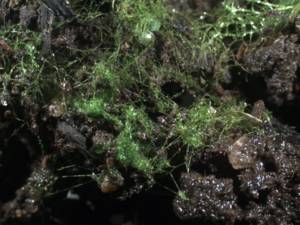Algae
Algae is a group of photosynthetic organisms found within aquatic and terrestrial environments. These organisms can provide benefits or damages, depending on the environment and nutrients available within.

Description and Characteristic
Algae are a group of cells that form in the same uniformity as vascular plants in either matted/ branched colonies, or can be seen in leafy or blade forms. The word "algae" comes from macroalgae, along with diverse group of microorganisms know as microalgae. There are known to be about 30,000 to 1 million species of algae including species from fossilized algae. [1][3]
Algae can come in many different colors based on the type of algae. Most known colors are blue and green which can indicate Cyanobacteria known as blue-green algae or Chlorophyta known as green algae. These two are the most common to be found in soil. For Chlorophyta the color ranges in shades of green from yellow-green to blackish-green depending on the levels of chlorophyll concentrations. [2][3]
Reproduction
Algae's reproduction varies based on the type of algae it is. For Cyanobacteria and general algae, it involves cell division followed by cell separation for unicellular organisms. For multicellular organisms can involve either asexually or sexually reproduction. Eukaryotic microalgae reproduce sexually and complete genome sequences for some algae in which sexual production is not observed to show that organisms do have genetic apparatus needed for meiosis, which is essential. The sexual reproduction involves the release of gametes and fertilization in moist/wet areas. [3]
Habitat and Environment
Algae are known to be found in soils, around tree trunks rocks and within protozoans, hydras and or lichen fungi. They can also sometimes be found on the surface of snow.[2] Algae also depend on photosynthesis for areas to live, areas with abundant sunlight make this easier. Algae will form due to poor soil nutrients, excessive moisture in soil, temperatures cooling, and poor drainage.[4] But algae is beneficial to soil because they contribute to soil formation and the stability of mature soils. Algae is also nitrogen fixing. Algae contributes to nitrogen in the soil through biological nitrogen fixation. Another benefit is the generation of organic matter from inorganic substances. They also provide food for bacteria and invertebrates. Algae can also help soil erosion by producing extracellular polysaccharides and forming water stable aggregates which helps reduce wind erosion.[5]
Sources
[1] Barsanti, L., and Paolo Gualtieri. Algae : Anatomy, Biochemistry, and Biotechnology. Third edition., CRC Press, 2023.
[2] Algae Classification | Smithsonian National Museum of Natural History. (n.d.). https://naturalhistory.si.edu/research/botany/research/algae/algae-classification.
[3] Raven, J. A., and M. Giordano. 2014. Algae. Current Biology 24:R590–R595.
[4] Algae | UC Agriculture and Natural Resources. 2025, February 26. https://ucanr.edu/county-office/cooperative-extension-ventura-county/algae.
[5] Zancan, S., R. Trevisan, and M. G. Paoletti. 2006. Soil algae composition under different agro-ecosystems in North-Eastern Italy. Agriculture, Ecosystems & Environment 112:1–12.